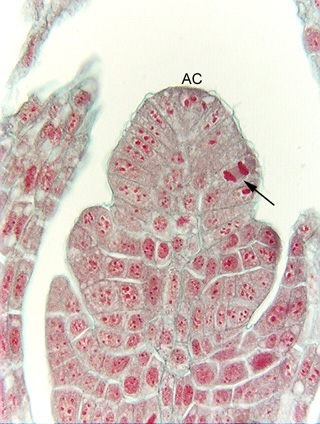 Fig. 6.3-2.
Longitudinal section of a shoot tip of horsetail (Equisetum arvense, also
called scouring rush). Like ferns, equistems are plants that reproduce with just
spores, not seeds, and similarly, their shoot apical meristems have a prominent
apical cell. The cell itself is not particularly easy to see in this micrograph,
but notice cells (and their nuclei) on either side: all the cells are rather
flat and brick-shaped, and they are oriented parallel to the sides of the apical
cell. In the apex of Nephrolepis (Fig. 6.3-1b), the lateral progeny cells
quickly undergo a transverse division, but here they do not do that, so it is
easier to see that these cells are related to the apical cell.
Fig. 6.3-2.
Longitudinal section of a shoot tip of horsetail (Equisetum arvense, also
called scouring rush). Like ferns, equistems are plants that reproduce with just
spores, not seeds, and similarly, their shoot apical meristems have a prominent
apical cell. The cell itself is not particularly easy to see in this micrograph,
but notice cells (and their nuclei) on either side: all the cells are rather
flat and brick-shaped, and they are oriented parallel to the sides of the apical
cell. In the apex of Nephrolepis (Fig. 6.3-1b), the lateral progeny cells
quickly undergo a transverse division, but here they do not do that, so it is
easier to see that these cells are related to the apical cell.